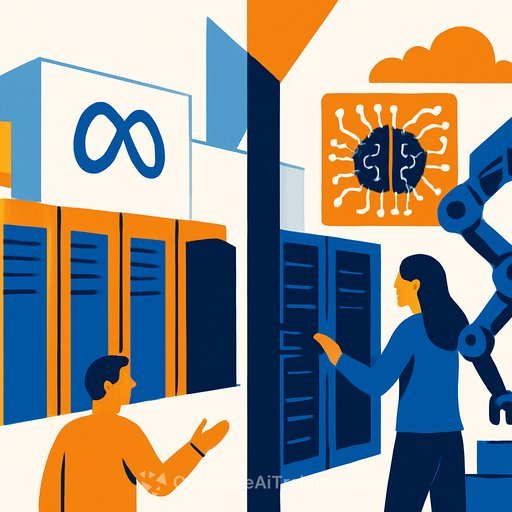Meta Q3 2025: Record Revenue, EPS Hit by One-Time Tax Charge
Meta posted its highest-ever quarterly revenue at $51.24bn, beating both internal guidance and Street estimates. Earnings per share landed at $1.05 versus $6.70 expected, driven by a one-time non-cash income tax charge of $15.93bn. On a normalized basis, EPS would have been $7.25.
Guidance tightened around growth and spend. Q4 revenue is projected at $56-$59bn. Full-year total expenses are now $116-$118bn (up at the low end), and 2025 capex is pegged at $70-$72bn, up from $66-$72bn.
Key Drivers This Quarter
- Top line: $51.24bn revenue reflects ongoing ad demand and product scale.
- Bottom line: GAAP EPS compressed by a $15.93bn one-time tax charge; underlying earnings power points higher with a $7.25 EPS ex-charge.
- AI infrastructure: Spend continues to ramp as Meta builds out compute capacity and models under its Superintelligence Labs banner.
- Reality Labs: The unit behind VR and new Ray-Ban Display glasses posted a $4.4bn loss, reaffirming long-dated return profiles for hardware bets.
- Workforce: After an AI hiring spree, Meta cut 600 roles to streamline its "super-intelligence" unit, bringing headcount there to just under 3,000.
- Data centers: A new joint venture with Blue Owl Capital targets the $27bn Hyperion campus in Louisiana-Meta's largest development to date.
Spend Trajectory and 2026 Setup
Management is firm: the investment cycle isn't easing. CFO Susan Li said the company will need to "invest aggressively" in 2026 to meet compute needs. Expenses are expected to grow at a significantly faster percentage rate in 2026 than in 2025.
Primary drivers: infrastructure (including incremental cloud costs and depreciation) and compensation. Meta will recognize a full year of pay for employees hired throughout 2025, with additional technical hiring in priority areas, especially AI.
Strategy: Scale AI, Ship to Billions
CEO Mark Zuckerberg framed Meta AI as a "massive latent opportunity," with research efforts feeding capabilities that ship across family-of-apps and devices. He highlighted early momentum in Meta Superintelligence Labs and continued leadership claims in AI glasses. The bet is simple: build the capability, then distribute at consumer scale.
Advertising and Brand Safety
Meta lost accreditation from the Media Rating Council after opting out of annual audits. While the seal signals content safety controls to brands, analysts expect limited impact due to Meta's scale and performance. Still, some brand-sensitive budgets may stay cautious until measurement confidence is restored.
For context on the accreditation program, see the Media Rating Council. Full filings and metrics are typically posted on Meta's investor relations.
Glasses: Promise vs. Profit
New Ray-Ban Display glasses launched with an embedded lens screen, extending Meta's AI wearables push. Popularity and buzz aside, the segment is still deeply loss-making today, and privacy concerns continue to surface, including reports of a $60 mod that disables the recording light. Expect a long payback period unless attach rates, ARPU, or ecosystem monetization inflects.
What This Means for Finance Teams
- Modeling EPS: Treat Q3's $15.93bn tax charge as non-recurring for run-rate EPS and valuation comps, but keep a close eye on any follow-on tax or restructuring impacts.
- Capex to D&A: With 2025 capex at $70-$72bn and more growth in 2026, depreciation will climb. Update D&A ramps and assess margin pressure as assets enter service.
- FCF and ROIC: Elevated infrastructure spend will weigh on near-term FCF. Revisit ROIC frameworks tied to AI monetization milestones and utilization rates.
- Opex line items: 2026 expense growth skewed to infrastructure and compensation. Bake in wage inflation for high-end AI talent and cloud commitments.
- Ad durability: Despite MRC accreditation loss, advertiser performance often wins. Watch CPMs, impression growth, and signal quality to validate budget resilience.
- Hardware optionality: Glasses and VR remain strategic but are a drag today. Treat as call options; don't credit the P&L until adoption and monetization paths firm up.
Risks and Watch List
- Guidance: Track Q4 revenue delivery ($56-$59bn) and any updates to 2025-2026 spend contours.
- Utilization: Evidence that new AI infrastructure is fully utilized (model performance, product releases) will matter for return profiles.
- Advertising: Any sustained impact from accreditation loss or heightened brand-safety pressure.
- Privacy and regulation: Wearables scrutiny, especially around recording indicators and data use, could trigger policy or product changes.
- Hiring cadence: Compensation drift from AI talent density and ongoing technical additions.
Bottom Line
Operationally, Meta is executing on growth and pushing hard on AI capacity. Financially, the one-time tax hit masks healthier underlying earnings, but the real story is spend: capex up, opex up, and more to come in 2026. If AI products scale across billions of users, the payoff could be meaningful-timing and efficiency are the variables.
Helpful Resource
If you're benchmarking AI spend or tooling for finance teams, this curated list may help: AI tools for finance.
Your membership also unlocks:





